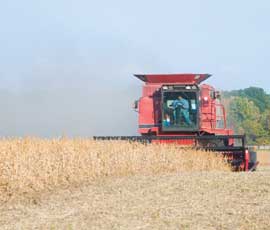Falling soya-bean yields send protein prices soaring

It was concern over the size of the current soya-bean crop that sent prices through the £300/t barrier last month, following a series of reductions in expected harvest volumes.
The latest report from the US Department of Agriculture (USDA) now estimates the Brazilian soya-bean harvest at 68.5 million tonnes (mt), with Argentina predicted to produce 46.5mt, together down by about 9mt compared to last year.
Soya bean
It’s a significant reduction and current best estimates put global soya-bean production down 19mt compared to last year – the largest year-on-year drop on record.
Difficulties getting the Brazilian harvest underway due to poor weather only added to the problem in early March, with a number of countries switching to the USA for supplies in the short term. In one week alone, the US exported 1mt of soya beans (including 460,000t to China) at a time when very little is normally sold from North America.
The potential impact this trade might have on US year-end stocks has put further pressure on forward prices, and although the latest USDA report left year-end stock estimates unchanged at about 7.5mt, the market does expect this figure to drop in due course. At present, the big unknown is potential Chinese demand, with the volumes involved capable of having a big influence on the market.
The steady rise in prices since the start of the year has also encouraged the investment funds to re-enter the market. The higher prices go, the more likely it is that we’ll see some fund-selling as investors cash-in their profits, resulting in possible short-term dips in the market – good opportunities to cover soya-bean meal requirements for the next month or two to guard against the market going even higher.
Rapemeal
Rapemeal also remains in tight supply. The crushers are sold out of rapemeal until April, and the high price of old-crop rapeseed, along with a static oil market, has many crushers running at reduced capacity as margins fail to stack up. The result could be a much lower than normal volume of rapemeal on the market going into early summer.
It means that although there’s still a £10/t discount for early summer rapemeal compared to the spot market, at £194/t it’s no longer the good buy it was a short while ago. However, the price for Aug-Oct delivery, at about £176/t, does look better value, particularly if no cover for that period has yet been taken.
This later discount is being helped by an improved outlook for the European oilseed rape crop now that concerns over potential winter kill due to the extreme cold weather have quietened down. Germany, for example, is now predicting a 4.8mt crop, significantly higher than the weather-damaged 3.8mt crop of last year.
Energy
On the energy feed markets, estimates for global wheat supplies have also been reduced, to 689mt compared to 696mt last year. For the moment, this volume is still more than adequate to meet anticipated demand, particularly now that concerns regarding weather damage to crops in Europe and the USA are falling away.
As a result, the markets have remained relatively quiet, yet trending upwards, with May wheat futures back above £170/t at the time of writing. The main cause of this increase seems to be the logistical problems that continue to prevent Black Sea region exports, though the sporadic re-emergence of worries regarding the Greek debt crisis is still producing occasional dips in the market – potential opportunities to secure at least some cover going forwards.
The release of figures for US corn plantings at the end of March should help ease concerns over potential supply, but a shortage of old crop will limit the impact until the crop is in the ground and growing well. Below average rainfall across many of the world’s key cereal growing regions is also expected to be corrected during the coming months.
In the meantime, continue to make the most of the opportunity to use molasses- and distillery-syrup-based liquid feeds to supply more cost-effective energy, and focus on soya hulls for summer digestible fibre needs.
Feed markets at a glance
Soya-bean meal:
Soya-bean meal back above £300/t
Record drop in global soya-bean production
Fund selling likely as market nears peak
Cover one to two months ahead when market dips
Rapemeal:
Rapemeal supply now tight until mid-summer
Prices up sharply; late summer better value
Energy feeds:
Global wheat production down to 689mt
Markets quiet, but still rising
Molasses and distillery syrups best value
